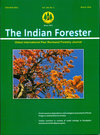Diversity and Distribution of Macrophytes in Fresh Waterbodies under Varying Degree of Anthropogenic Pressures
DOI:
https://doi.org/10.36808/if/2018/v144i3/122757Keywords:
Macrophytic Diversity, Anthropogenic Pressure, Fresh Water Bodies, Restoration.Abstract
The present paper communicates the ecological survey and distribution pattern of macrophytic diversity in some freshwater bodies of Billawar tehsil, Kathua district, J&K, India, located in the areas under varying degree of anthropogenic pressures. The study revealed the presence of 21 macrophytic species belonging to 19 genera and 15 families with highest diversity of emergent species (12 species) followed by rooted floating type and free floating type (03species each), submerged (02 species) and marginal (01 species) type. Among various water bodies selected for the present study, Stream A has shown maximum diversity (13 species) and Spring A minimum diversity (2 species). Family Polygonaceae and Apiaceae, among various families, have shown dominance followed by Apiaceae and Lemnaceae, respectively. Minimum percentage similarity of macrophytic diversity among different water bodies has been observed between ponds and springs (15.38%) and maximum between springs and streams (42.1%). The study recommends the urgent need for restoration, improvement and proper management of these water bodies in order to conserve the macrophytic diversity of the study area.References
Adoni A.D., Joshi G., Gosh K., Chourasia S.K., Vaishya A.K., Yadev M. and Verma H. G. (1985) Workbook on Limnology, Pratibha Publishers, Sagar. 96-105 pp.
Biswas K. and Calder C.C. (1954). Handbook of common water and marsh plants in India and Burma. Health Bull. No. 24: (Govt. Press, Calcutta); ed. 2. 1-216 pp.
Bornette G. and Puijalon S. (2011). Response of aquatic plants to abiotic factors. Aquatic Sciences,73(1): 1-14.
Brix H. (1994). Functions of macrophytes in constructed wetlands. Wat. Sci. Tech., 29:71-78.
Chambers P., Lacoul P., Murphy K.J. and Thomaz, S.M. (2008). Global diversity of aquatic macrophytes in freshwater. Hydrobiologia, 595: 9 – 26
Cook C.D.K. (1990). Aquatic plant book. SPB Academic Publishing, The Hague, 1-228.
Costanza R., Arge R., Groot R., Farber S., Grasso M., Hannon B., Limburg K., Naeem S., Neill J.P., Robert V.O., Parelo J., Robert G., Sutton P. and Belt M. (1998). The value of ecosystemservices: putting the issues in perspective. Ecological economics, 25:67- 72.
Daubenmire R. (1968).Plant communities: A textbook of plant synecology. Harper and Row, New York. 300 pp.
Deshmukh U. B. Shende M.B. and Rathor O.S. (2016). Aquatic macrophytes biodiversity assessment from Asolamendha reservoir of Chandrapur district, Maharashtra State (India). Inter. J. Applied Research, 2(1): 293-298
Egertson C.J., Kopaska J.A. and Downing J.A. (2004). A century of change in macrophytes abundance and composition in response to agricultural eutrophication. Hydrobiologia, 524: 1-38.
Engelhardt K.A. and Ritchie M.E. (2001). Effects of macrophytes species richness on wetland ecosystem functioning and services. Nature, 411: 687-689.
Kumar S. and Chelak E.P. (2015). Survey of macrophytic diversity in different ponds of ongargarh city of Chhattisgarh. IOSR J. Environmental Science. Toxicology and Food Technology, 1(1): 57-59
Pandey P. and Gopal B. (2010). Effect of detergents on the growth of two aquatic plants: Azolla pinnata and Hydrilla verticillata. Environ. We Int. J. Sci. Tech., 5: 107-114.
Pandit A.K. (1984). Role of macrophytes in aquatic ecosystems and management of fresh water resources. J. Environmental Management, 18: 73-88
Dhote S. (2007). Role of macrophytes in improving water quality of an aquatic eco-system. J. Appl. Sci. Environ. Mngt., 11(4):133–135.
Sørensen T.J. (1948). A method of establishing groups of equal amplitude in plant sociology based on similarity of species content and its application to analyses of the vegetation on Danish commons. K. Dan. Vidensk. Selsk. Biol. Skr. 1–34pp.
Spence D.H.N. (1967).Factors controlling the distribution of fresh water macrophyteswith particular reference to the loch of Scotland. J. Ecol., 55: 147-170
Thomaz S.M. and Ribeiro E. (2010). The role of macrophytes in habitat structuring in aquatic ecosystem: methods of measurement, causes and consequences of animal assemblages, composition and biodiversity. Acta Limnologica Brasiliensia, 22 (2):218-236.
Tijare R.V. (2011). A study of macrophytic vegetation present in the lentic waterbodies of Gadchiroli, Nagpur. (india). Golden Research Thoughts, 1(4): 1-8
Topuzovic M., Pavlovic D. and Ostojic A. (2015 ). Temporal and habitat distribution of macrophytes in lowland eutrophic reservoir Gruža in Serbia. Periodicum Biologorum, 117(4): 67–73
Wang Q., Cui Y. and Dong Y. (2002). Phytoremediation of polluted waters; potentials and prospects of Wetland Plants. Engineering in Life Sciences, 22: 199-208.
Ward H.B. and Whipple G.C. (1959).Freshwater biology, 2nd ed., Edmondson, W. T. John Wiley and Sons. New York. 1248 pp.
Zutshi D.P., Subla B.A. Khan M.A and Wanganeo A. (1980). Comparative limnology of nine lakes of Jammu and Kashmir Himalaya. Hydrobiologia, 72: 101-112
Zutshi D.P. and Gopal B. (1990). Structure and dynamics of plant communities. In: Ecology and management of aquatic vegetation in the Indian subcontinent. (B. Gopal ed.) Kluwer Academic Publisher, London.127-146 pp.
Downloads
Downloads
Published
How to Cite
Issue
Section
License
Unless otherwise stated, copyright or similar rights in all materials presented on the site, including graphical images, are owned by Indian Forester.





